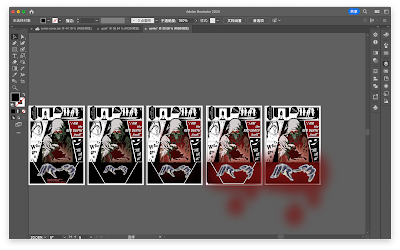Illustration & Narrative- Task3: Comic Design
05/6/2024--05/7/2024 (Week11-Week14)
JING KEYAO/0370732/Bachelor of Design (Honours) in Creative Media
Illustration & Narrative
Task 3
Table of Content:
1. Lectures
Week11
Week12
2. Instruction & Exercises
·Ideation
·Cover Page
·Comic Strip
·Animated
3. Reflection
LECTURES:
Week11
1. Central theme
It’s the main idea or underlying meaning. Often, it’s the storyteller’s personal opinion on the subject matter. A story may have both a major theme and minor themes.
Major Theme: An idea that is intertwined and repeated throughout the whole narrative.
Minor Theme: An idea that appears more subtly, and doesn’t necessarily repeat.
2. Conflict
The conflict drives the story. It creates tension and build suspense. Conflict engages an audience.
3. Characters
A story usually includes a number of characters, each with a different role or purpose.
Central Character: The main character of a story
Protagonist: Main character of a story, he or she will usually have a clear goal to accomplish or a coonflict to overcome.
Antogonist: Antgonists oppose protagonists, standing between them and their ultimate goals.
3. 3-Acts Structure
Setup: Introduction of the world which the protagonist exists.
Rising Tension: The series of obstacles the protagonist must overcome
Conflict: The point of highest tension.
Resolution: The conflict's resolution.
Week12
Mr Hafiz wanted us to break down the selected story by using the 2-Acts Structure. We need to highlight the part we want to visualize (intro, rising action, climax...). Mr Hafiz introduced the charcateristic of sequential art, an art form to convey a story.
If the image presented individually, viewer will think it's just a sun. However, If the both image presented at the same time, viewer will know it's a sunset scene.
These are some common transitions:
Moment-To-Moment
Action-To-Action
Subject-To-Subject
Scene-To-Scene
Aspect-To-Aspect
Instruction & Exercises:
Module Brief:
<iframe src="https://drive.google.com/file/d/1mUnVqv8MqE03RlU-IIFBNdL-H98XAn_w/preview" width="640" height="480" allow="autoplay"></iframe>
- Ideation
I chose "The Masque of the Red Death" for my comic creation because its themes of fear, inevitability, and the haunting presence of death offer a rich and compelling narrative to visually explore. The story's intense atmosphere and striking imagery provide ample opportunity to create a dramatic and engaging visual experience.
- Cover Page
1. Used a blood-red eye as the visual centerpiece, symbolizing death and fear. The eye design was inspired by the characteristics of the "Red Death" in the story.
2. Color Choice: Primarily used red, black, and yellow to emphasize the story's bloody and tense nature.
3. Typography Design: The title is in large, bold black font placed against a red background to create a strong visual impact.
- Comic Strip
1. Character Depiction: The embodiment of the Red Death appears as a skeleton with glowing red eyes, enhancing the horror.
2. Background Setting: Utilized high-contrast black and white backgrounds to highlight characters and events. And the transitions between scenes achieved through black fills and strong contrasting lines.
3. Atmosphere Creation: Used shadows and high-contrast colors to create a tense and oppressive atmosphere.
Overall Sketch
Overall :
1. Narrative Structure: The story begins with a mysterious figure entering the palace, gradually leading to the reveal of the Red Death. Then, The middle section uses dialogue and character actions to showcase the terror and threat of the Red Death.
2. Ending Design: The final panel depicts everyone collapsing, reflecting the story's conclusion—"the joy of the party turns into the end of the nightmare."
The contrast between the initial and final scenes highlights the destructive power of the Red Death.
3. Detailed depiction of hands emphasizes the arrival of death and the inevitable fate.
- Animated
·Final
Comic Cover_jpg
Comic Cover_jpg_pdf
Comic Strip_jpg
Comic Strip_jpg_pdf
Comic_gif
Comic_gif_pdf
Reflection:
During this semester, I experienced the process of creating comics using Adobe Illustrator and animating them with Photoshop. This journey was both challenging and rewarding.
Using Illustrator to create comics taught me a lot of professional knowledge. The vector drawing tools are perfect for creating clear, detailed lines and shapes. By mastering the pen tool, I was able to precisely draw complex characters and scenes. Applying color theory and gradient tools helped me infuse vibrant colors and layers into the comics, making the artwork more appealing.
Animating with Photoshop was another crucial learning experience. Using the timeline and keyframes, I was able to create smooth animation effects. Frame-by-frame drawing and adjustments brought characters and scenes to life. The biggest challenge was ensuring smooth and natural animation, requiring constant adjustments of transitions between keyframes to ensure that each frame's movements adhered to physical laws and character traits.
Overall, this semester's learning experience not only improved my technical skills but also significantly enhanced my creativity and execution. Using Illustrator to create comics and Photoshop to animate them taught me how to turn static images into dynamic effects, laying a solid foundation for my future creative endeavors.










.gif)


.gif)


Comments
Post a Comment